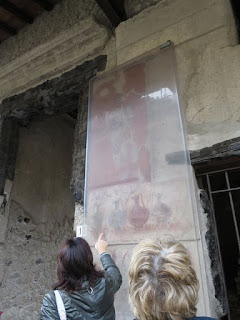We took a day while in the Amalfi area, to find out more about Vesuvius blowing it's top. Our Tour guide, Ada (pictures centre, below with red umbrella) did an excellent job of informing us. One mind blowing fact I can't get over, is that the still massive and active volcano, Vesuvius is now only 1/3 of it's size when it blew, in 79 AD. That makes Vesuvius SO massive, imagining it three times as high is well, mind blowing. 15 towns were wiped off the map when Vesuvius blew. In Pompeii, no one survived, and all died from the ash that came. In Herculaneum, 5 miles away, not everyone died. Many, but not all. What is really astounding, is that this small resort town was on the coast of the Mediterrannean, and after the volcano exploded, it was at least 1 mile from the newly formed coast. People here died from the actual lava flow. People who hid in arches of buildings were saved, as these were strong enough to hold over the flow of lava.
In the photo above, you see where the arches are at the bottom of the photo? That was the DOCK, and the sea came up to this point. Now, you can't see the sea from here at all.
Our guide Ada, showing us the traditional opening in the roof, to allow rainwater to fall into what looks like a wading pool. This water was collected and used for household chores and bathing.
The culture at the time of 79 AD enjoyed a rich lavish lifestyle. Everywhere, detailed frescoes and highly decorative homes.
This is the public bath. People would go here 3 or 4 times a day! Not just to bathe. This was the place where all levels of society would mingle with each other. The rich needed the poor and vice versa. So important plans could be laid here. Rich, asking favours of the poor and vice versa.
A highly decorative room- a typical example of some things being left in actual fair shape, while other buildings were completely irretrievable.
Ada is pointing out 4 vessels on the advertisement from 79 AD. Each vessel is a different colour, with it's price written below it. It's the cost of wine, with the most expensive at the left, and getting cheaper as you read to the right. The last one, would be the table wine we all drink nowadays. It wouldn't be terrible, but drinkable and affordable. This was a very sexually open society, and for the same cost of a bottle of cheap wine, one could purchase the services of a prostitute for the evening, for the same price as that of a bottle of wine. A very common practise then!
Another example of ornate decorative fixings, this design made of tiny pieces of marble laid into cement. Amazing! Many rooms has these tiny pieces of marble in the floors to reflect light at night time, and guide peoples' way in the dark.
This is what is left of a frescoed wall. The painting was mainly a yellow colour. The heat from Vesuvius had turned the frescoe red. It is permanent.
Our group listening intently.
When one of my students strayed and missed what guide was saying, I filled her in by telling her these were ancient public toilets. LOL. No, this is where wine was stored, and this was a wine store. It seemed like every second building on the main drag was a wine store. Another interesting logical fact: When a town was being built, the main street was always east/west, to get the most amount of sunshine/light in the street. Smart.
One of the best preserved frescoes in Herculaneum.
Our guide was able to explain the mindset of the people here when Vesuvius blew. They saw the fire on the top of the volcano, but thought it was just a fire. They had no idea that they would be dead in just a few hours. There was a man in Herculaneum with the foresight to write down all his observations about the whole event. This is one reason why we know so much about what happened. An amazing day, and amazing event observed.
Vesuvius is still active. The Italian government is trying to buy up the property close by Vesuvius and get anyone living near the crater to move away. Ada tells us the land is cheap!, and many would rather afford this place and take their chances. The area has several mini-earthquakes every day!
After leaving the area, we drove along the coast seeing the islands dotting the sea, like Capri. Ending the adventure in Naples eating Napolese Pizza and beer!











No comments:
Post a Comment